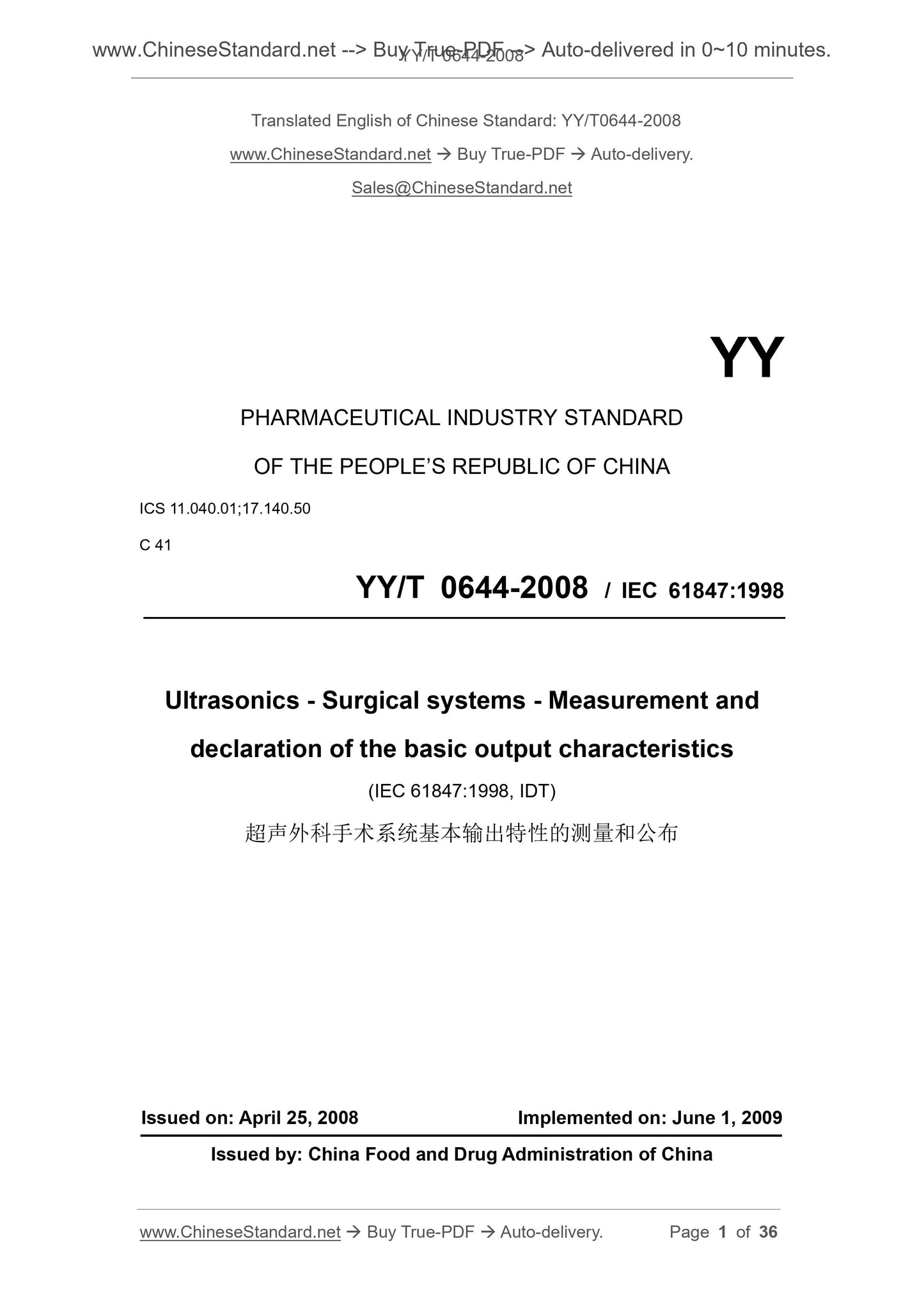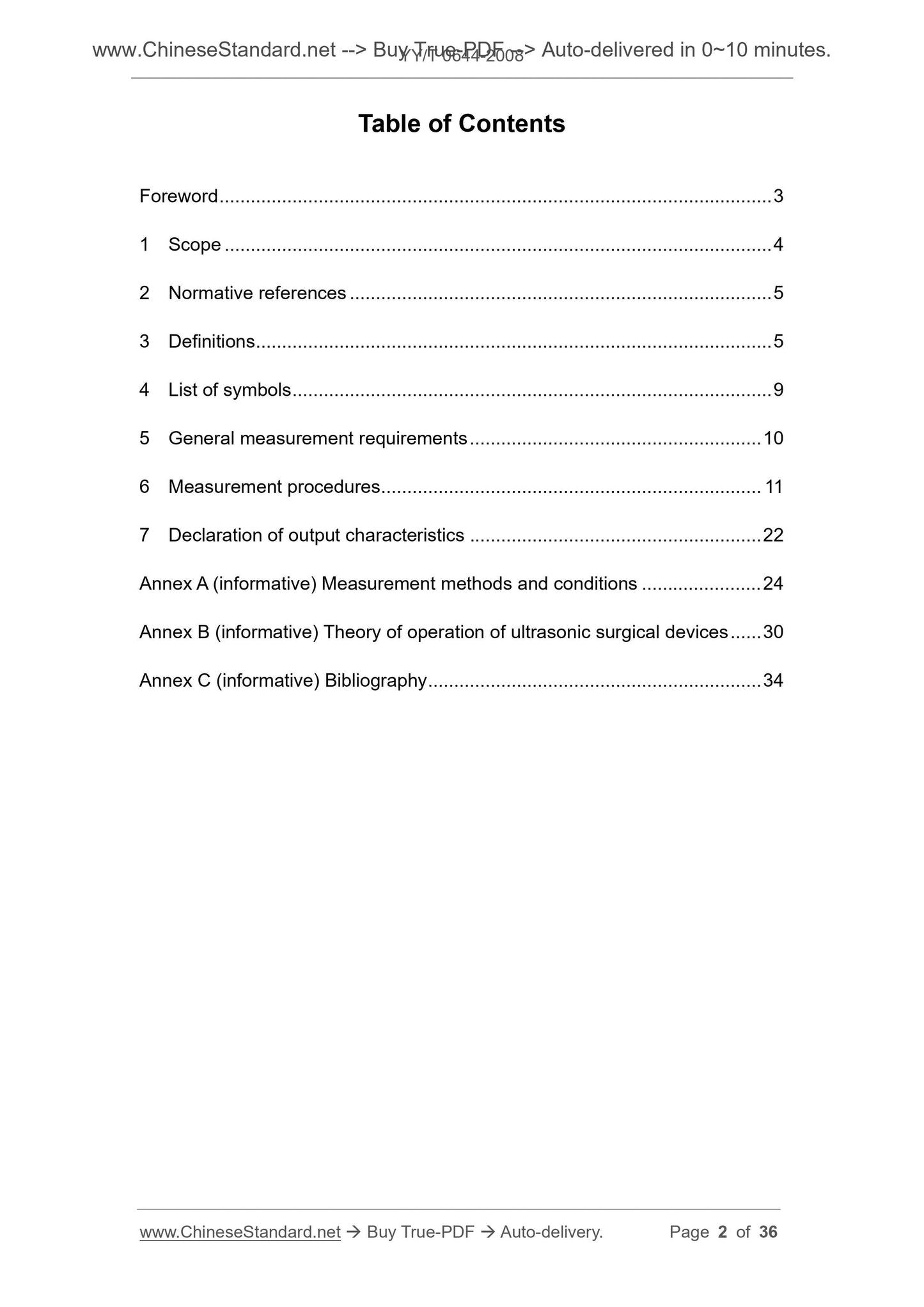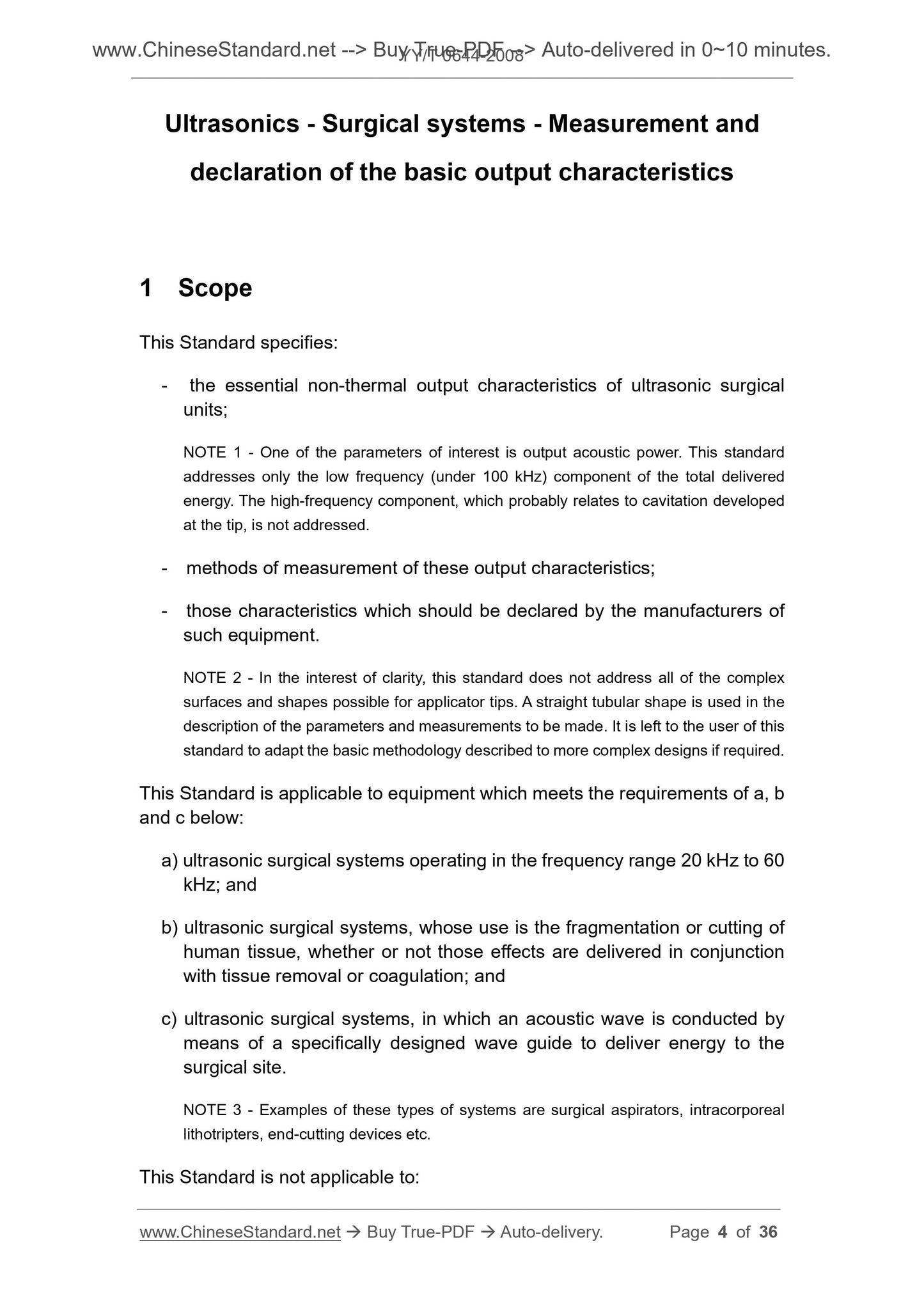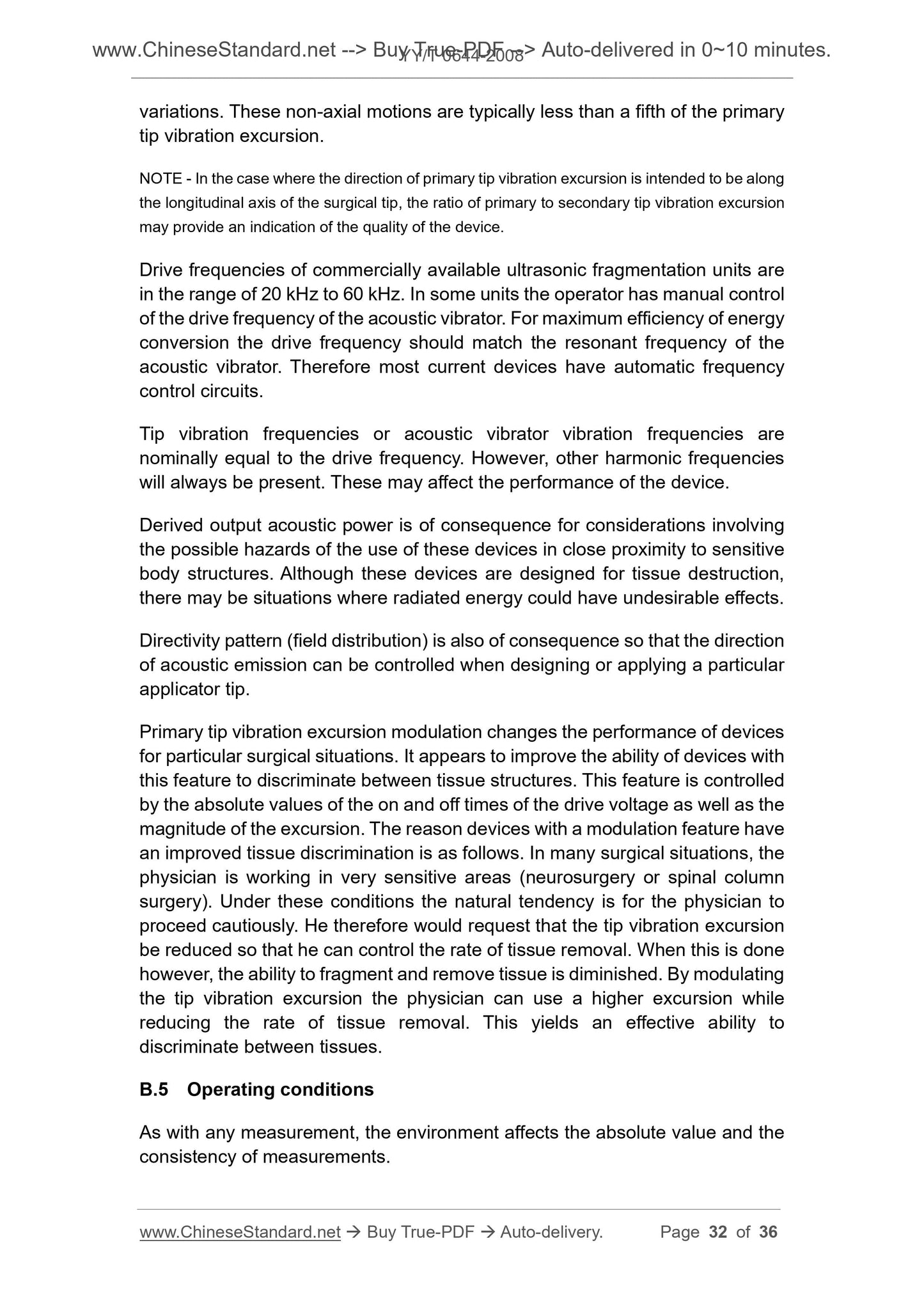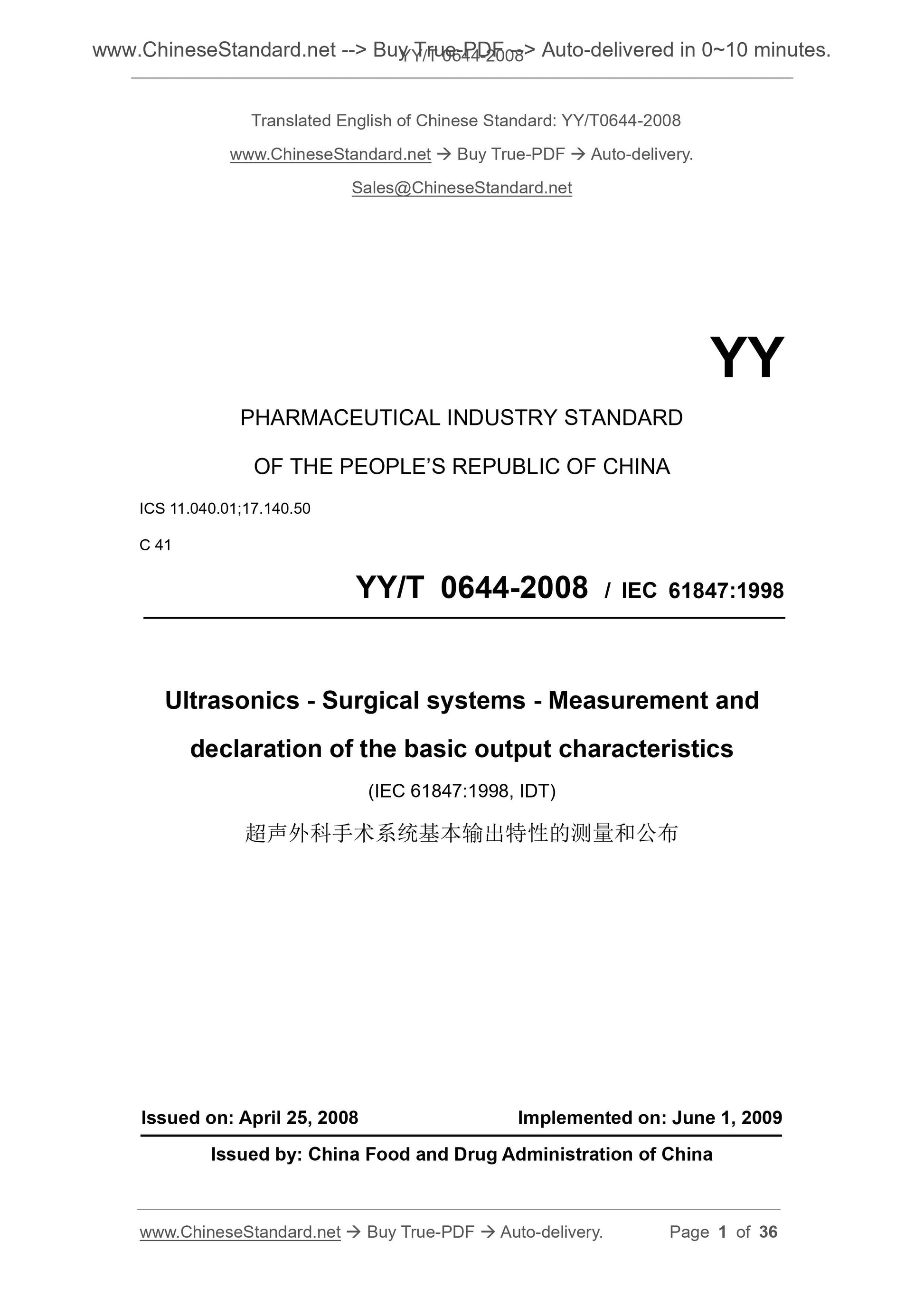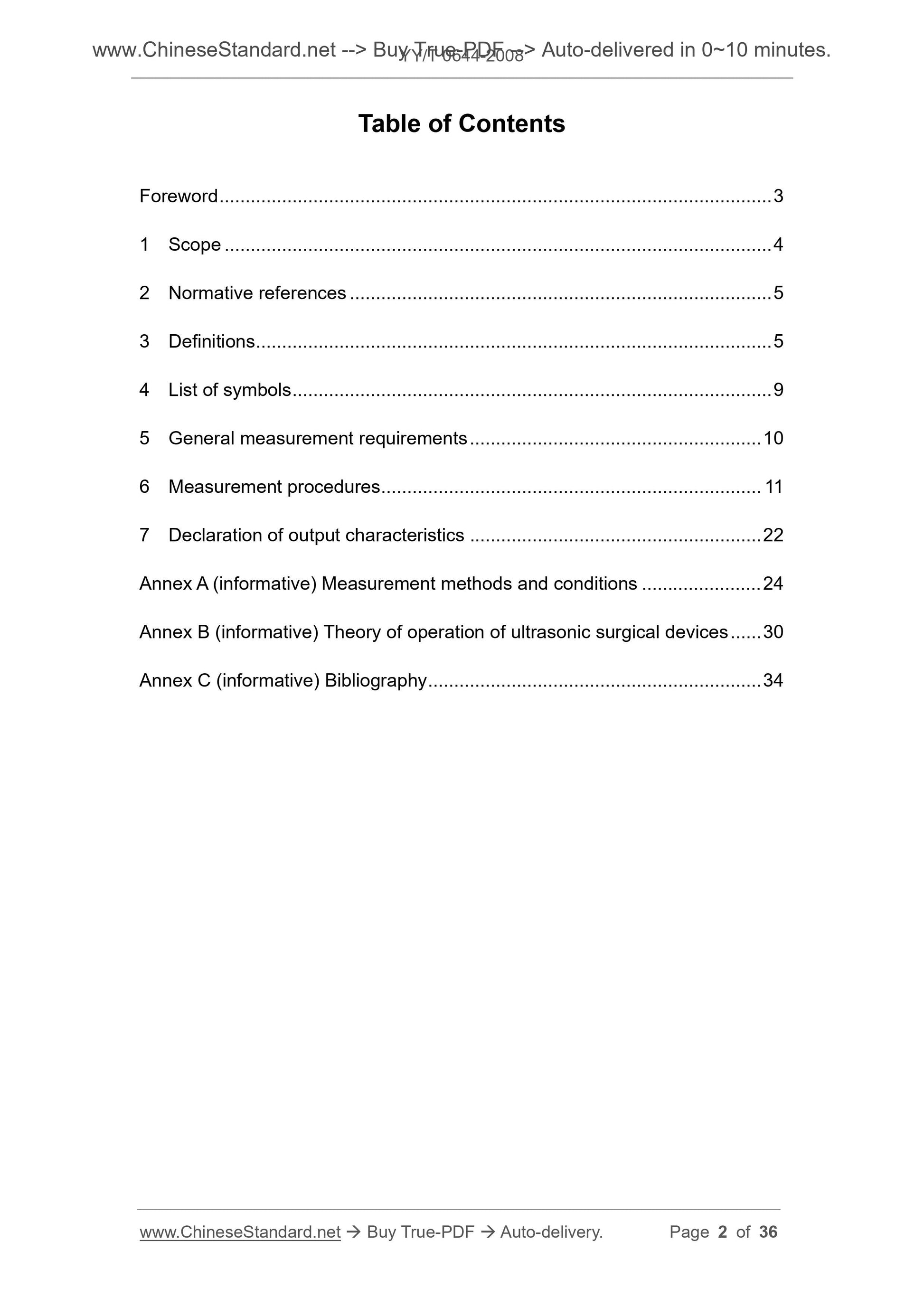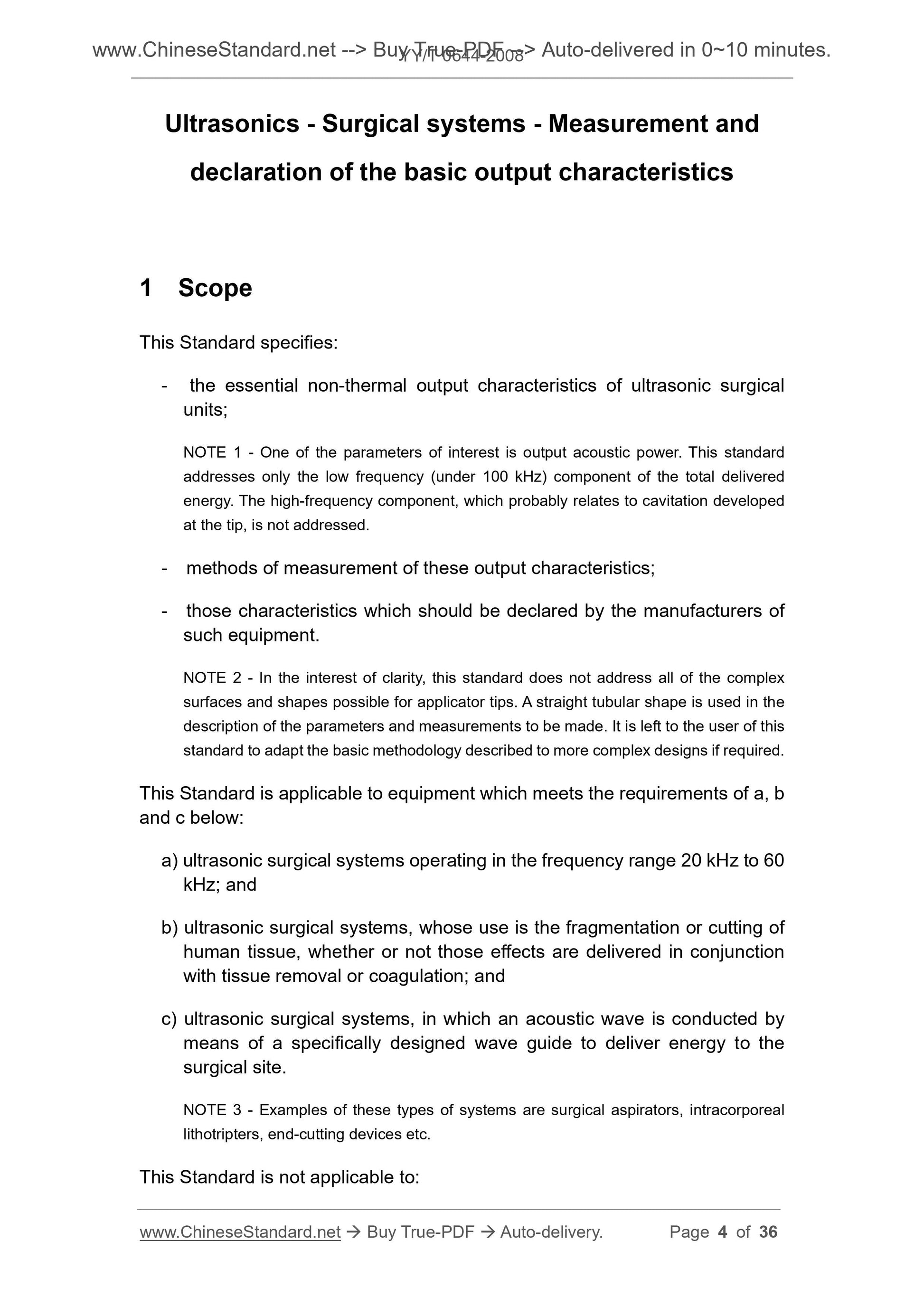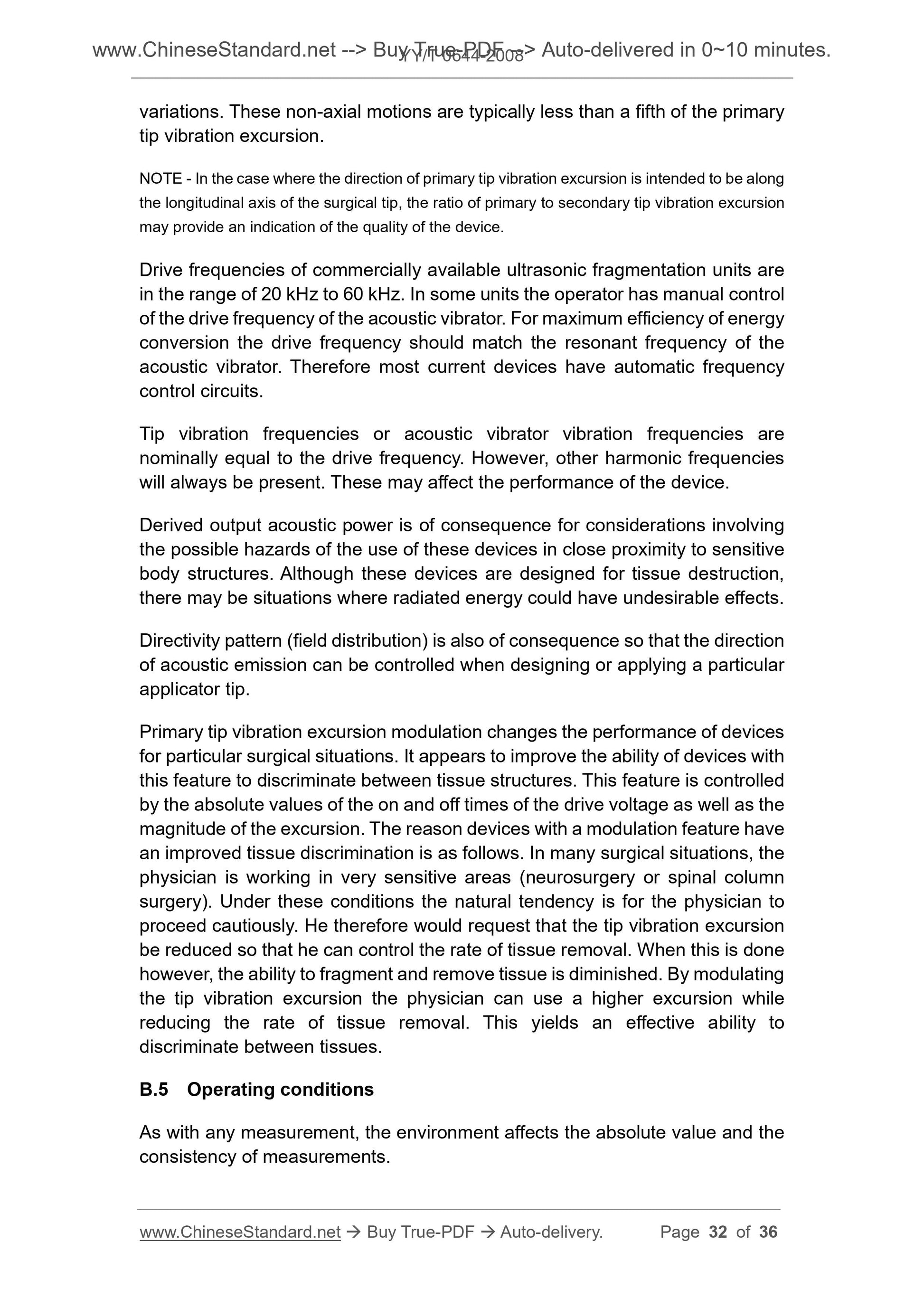PayPal, credit cards. Download editable-PDF and invoice in 1 second!
YY/T 0644-2008 English PDF (YYT0644-2008)
YY/T 0644-2008 English PDF (YYT0644-2008)
Precio habitual
$150.00 USD
Precio habitual
Precio de oferta
$150.00 USD
Precio unitario
/
por
Los gastos de envío se calculan en la pantalla de pago.
No se pudo cargar la disponibilidad de retiro
Delivery: 3 seconds. Download true-PDF + Invoice.
Get QUOTATION in 1-minute: Click YY/T 0644-2008
Historical versions: YY/T 0644-2008
Preview True-PDF (Reload/Scroll if blank)
YY/T 0644-2008: Ultrasonics-surgical systems. Measurement and declaration of the basic output characteristics
YY/T 0644-2008
Ultrasonics-surgical systems.Measurement and declaration of the basic output characteristics
ICS 11.040.01; 17.140.50
C41
People's Republic of China Pharmaceutical Industry Standard
YY/T 0644-2008/IEC 61847.1998
Basic output characteristics of ultrasound surgical systems
Measurement and publication
(IEC 61847.1998, IDT)
Released on.2008-04-25
2009-06-01 implementation
State Food and Drug Administration released
Foreword
This standard is equivalent to the use of IEC 61847.1998 "Measurement and publication of the basic output characteristics of ultrasonic surgical systems."
This standard changes the "this international standard" in the original text to "this standard" and makes a very small amount of editorial changes, which does not affect the degree of consistency.
Appendix A and Appendix B of this standard are informative annexes.
This standard is under the jurisdiction of the National Technical Committee for Standardization of Medical Ultrasound Equipment.
This standard was drafted. National Wuhan Medical Ultrasonic Instrument Quality Supervision and Testing Center.
The main drafters of this standard. Busan Anshi, Wang Zhiwei.
YY/T 0644-2008/IEC 61847.1998
Basic output characteristics of ultrasound surgical systems
Measurement and publication
1 range
This standard specifies.
--- The main non-thermal output characteristics of the ultrasound surgical system;
Note 1. One specific parameter involved is the output sound power. This standard only considers the low frequency component (below 100 kHz) of the total released energy, which may be related to
The cavitation-related high frequency components produced by the tip are not taken into account.
---Measurement method of output characteristics;
--- The characteristic parameters that the equipment manufacturer should publish.
Note 2. For the sake of simplicity, this standard does not consider all possible complex appearances and shapes of the tip of the treatment head. Explain the parameters and measurements in a straight line
The tip of the tube shape is taken as an example. If required, users of this standard apply more complex designs using the basic methods described in the standard.
The equipment to which this standard applies shall also meet the requirements of a), b) and c) below.
a) operate in the frequency range of 20kHz to 60kHz;
b) for the breaking or cutting of human tissue (regardless of whether these effects are related to the removal or solidification of the tissue);
c) Sound waves transmit energy to the surgical site through specially designed waveguides.
Note 3. Examples of this type of system are surgical aspirator, internal lithotripter, end cutting device, and the like.
This standard does not apply to.
--- A gravel device that introduces a pressure pulse in vitro and focuses through a liquid medium and human soft tissue;
---Surgical device (thermotherapeutic system) as part of the treatment process;
--- The surgical application where the acoustic application site is not at the tip of the longitudinal vibrating treatment tip and therefore does not conform to the unipolar model used in this standard.
Note 4. In this standard, the term “accuracy” refers to the total uncertainty at the 95% confidence level.
2 Normative references
The terms in the following documents become the terms of this standard by reference to this standard. All dated references, followed by all
Modifications (not including errata content) or revisions do not apply to this standard, however, parties to agreements based on this standard are encouraged to study
Is it possible to use the latest version of these files? For undated references, the latest edition applies to this standard.
IEC 60500.1974 IEC standard hydrophone
IEC 61205.1993 Measurement and publication of output characteristics of ultrasonic dental descaling systems
3 Terms and definitions
The following terms and definitions apply to this standard.
3.1
The part of the surgical system that is in direct contact with human tissue.
3.2
At a constant distance from the tip of the treatment tip, the sound pressure varies with the normalization of the angle.
Note. This parameter is important when working near the inner wall cells in stress- and motion-sensitive human structures such as the cornea and auditory nerves.
YY/T 0644-2008/IEC 61847.1998
Unit. dimensionless
3.3
The average frequency of the excitation voltage or current.
Note. Combining this parameter with the tip vibration displacement allows the user to estimate the vibration velocity at the tip of the treatment tip.
Unit. kilohertz (kHz)
3.4
For systems that modulate the type of electrical excitation power, the duration of the voltage or current pulse is consistent with the duration of the device's operation.
The ratio of continued time.
Symbol. Dcy
Unit. dimensionless
3.5
When the load at the tip of the treatment head is gradually increased from static (ie, no-load state, the same below), the peak input of the ultrasonic hand-held component
power.
Note. Peak electrical power occurs when the tip primary amplitude begins to decrease from its value corresponding to static (no-load) electrical power (see 6.9 and 6.10).
Symbol. Pmax
Unit. tile (W)
3.6
The acoustic power measured by the calorimetry method to the tip of the treatment head to the water (see 6.5).
Note. Measurement of the sound power emitted by the tip of the treatment head with different output areas and/or amplitudes contributes to the application of the ALARA principle (ie in a reasonable range)
Use as low a radiation level as possible).
Symbol. Pa
Unit. milliwatt (mW)
3.7
The sound power emitted by the tip of the treatment head to the water derived from the measurement of the hydrophone method (see 6.5).
Note. Measurement of the sound power emitted by the tip of the treatment head with different output areas and/or amplitudes contributes to the application of the ALARA principle (ie in a reasonable range)
Use as low a radiation level as possible).
Symbol. Pad
Unit. milliwatt (mW)
3.8
The ratio of the maximum electrical power to the static (no-load) electrical power.
Note 1. The power reserve index allows the user to understand how much (extra) backup is required to maintain a constant tip amplitude under varying load conditions.
Power margin.
Symbol. Pi
Unit. dimensionless
Note 2. Only for devices using the same working mode, can directly compare the power reserve index of different devices, and perform piezoelectric and magnetostrictive devices.
Comparison is meaningless.
YY/T 0644-2008/IEC 61847.1998
3.9
The projected area of the solid portion of the tip of the tip is treated in the direction of the major amplitude of the tip.
Note. For different tips operating at the same amplitude and frequency, the primary acoustic output area is used to determine the energy radiated by the treatment tip (tip) end face.
Symbol. Aap
Unit. square millimeter (mm2)
3.10
The peak-to-peak displacement of the tip of the treatment head in the direction of maximum amplitude, the measurement point is located at the tip of the treatment tip at a free end (end) not exceeding
1mm (see 3.2 of IEC 61205.1993).
Note. The ability to break tissue is related to the dominant amplitude of the tip.
Symbol. 狊p
Unit. micron (μm)
3.11
For systems that modulate the type of electro-active power, the percentage change in tip main amplitude from maximum to minimum.
Symbol. Msp
Unit. dimensionless
3.12
For systems that modulate the ele...
Get QUOTATION in 1-minute: Click YY/T 0644-2008
Historical versions: YY/T 0644-2008
Preview True-PDF (Reload/Scroll if blank)
YY/T 0644-2008: Ultrasonics-surgical systems. Measurement and declaration of the basic output characteristics
YY/T 0644-2008
Ultrasonics-surgical systems.Measurement and declaration of the basic output characteristics
ICS 11.040.01; 17.140.50
C41
People's Republic of China Pharmaceutical Industry Standard
YY/T 0644-2008/IEC 61847.1998
Basic output characteristics of ultrasound surgical systems
Measurement and publication
(IEC 61847.1998, IDT)
Released on.2008-04-25
2009-06-01 implementation
State Food and Drug Administration released
Foreword
This standard is equivalent to the use of IEC 61847.1998 "Measurement and publication of the basic output characteristics of ultrasonic surgical systems."
This standard changes the "this international standard" in the original text to "this standard" and makes a very small amount of editorial changes, which does not affect the degree of consistency.
Appendix A and Appendix B of this standard are informative annexes.
This standard is under the jurisdiction of the National Technical Committee for Standardization of Medical Ultrasound Equipment.
This standard was drafted. National Wuhan Medical Ultrasonic Instrument Quality Supervision and Testing Center.
The main drafters of this standard. Busan Anshi, Wang Zhiwei.
YY/T 0644-2008/IEC 61847.1998
Basic output characteristics of ultrasound surgical systems
Measurement and publication
1 range
This standard specifies.
--- The main non-thermal output characteristics of the ultrasound surgical system;
Note 1. One specific parameter involved is the output sound power. This standard only considers the low frequency component (below 100 kHz) of the total released energy, which may be related to
The cavitation-related high frequency components produced by the tip are not taken into account.
---Measurement method of output characteristics;
--- The characteristic parameters that the equipment manufacturer should publish.
Note 2. For the sake of simplicity, this standard does not consider all possible complex appearances and shapes of the tip of the treatment head. Explain the parameters and measurements in a straight line
The tip of the tube shape is taken as an example. If required, users of this standard apply more complex designs using the basic methods described in the standard.
The equipment to which this standard applies shall also meet the requirements of a), b) and c) below.
a) operate in the frequency range of 20kHz to 60kHz;
b) for the breaking or cutting of human tissue (regardless of whether these effects are related to the removal or solidification of the tissue);
c) Sound waves transmit energy to the surgical site through specially designed waveguides.
Note 3. Examples of this type of system are surgical aspirator, internal lithotripter, end cutting device, and the like.
This standard does not apply to.
--- A gravel device that introduces a pressure pulse in vitro and focuses through a liquid medium and human soft tissue;
---Surgical device (thermotherapeutic system) as part of the treatment process;
--- The surgical application where the acoustic application site is not at the tip of the longitudinal vibrating treatment tip and therefore does not conform to the unipolar model used in this standard.
Note 4. In this standard, the term “accuracy” refers to the total uncertainty at the 95% confidence level.
2 Normative references
The terms in the following documents become the terms of this standard by reference to this standard. All dated references, followed by all
Modifications (not including errata content) or revisions do not apply to this standard, however, parties to agreements based on this standard are encouraged to study
Is it possible to use the latest version of these files? For undated references, the latest edition applies to this standard.
IEC 60500.1974 IEC standard hydrophone
IEC 61205.1993 Measurement and publication of output characteristics of ultrasonic dental descaling systems
3 Terms and definitions
The following terms and definitions apply to this standard.
3.1
The part of the surgical system that is in direct contact with human tissue.
3.2
At a constant distance from the tip of the treatment tip, the sound pressure varies with the normalization of the angle.
Note. This parameter is important when working near the inner wall cells in stress- and motion-sensitive human structures such as the cornea and auditory nerves.
YY/T 0644-2008/IEC 61847.1998
Unit. dimensionless
3.3
The average frequency of the excitation voltage or current.
Note. Combining this parameter with the tip vibration displacement allows the user to estimate the vibration velocity at the tip of the treatment tip.
Unit. kilohertz (kHz)
3.4
For systems that modulate the type of electrical excitation power, the duration of the voltage or current pulse is consistent with the duration of the device's operation.
The ratio of continued time.
Symbol. Dcy
Unit. dimensionless
3.5
When the load at the tip of the treatment head is gradually increased from static (ie, no-load state, the same below), the peak input of the ultrasonic hand-held component
power.
Note. Peak electrical power occurs when the tip primary amplitude begins to decrease from its value corresponding to static (no-load) electrical power (see 6.9 and 6.10).
Symbol. Pmax
Unit. tile (W)
3.6
The acoustic power measured by the calorimetry method to the tip of the treatment head to the water (see 6.5).
Note. Measurement of the sound power emitted by the tip of the treatment head with different output areas and/or amplitudes contributes to the application of the ALARA principle (ie in a reasonable range)
Use as low a radiation level as possible).
Symbol. Pa
Unit. milliwatt (mW)
3.7
The sound power emitted by the tip of the treatment head to the water derived from the measurement of the hydrophone method (see 6.5).
Note. Measurement of the sound power emitted by the tip of the treatment head with different output areas and/or amplitudes contributes to the application of the ALARA principle (ie in a reasonable range)
Use as low a radiation level as possible).
Symbol. Pad
Unit. milliwatt (mW)
3.8
The ratio of the maximum electrical power to the static (no-load) electrical power.
Note 1. The power reserve index allows the user to understand how much (extra) backup is required to maintain a constant tip amplitude under varying load conditions.
Power margin.
Symbol. Pi
Unit. dimensionless
Note 2. Only for devices using the same working mode, can directly compare the power reserve index of different devices, and perform piezoelectric and magnetostrictive devices.
Comparison is meaningless.
YY/T 0644-2008/IEC 61847.1998
3.9
The projected area of the solid portion of the tip of the tip is treated in the direction of the major amplitude of the tip.
Note. For different tips operating at the same amplitude and frequency, the primary acoustic output area is used to determine the energy radiated by the treatment tip (tip) end face.
Symbol. Aap
Unit. square millimeter (mm2)
3.10
The peak-to-peak displacement of the tip of the treatment head in the direction of maximum amplitude, the measurement point is located at the tip of the treatment tip at a free end (end) not exceeding
1mm (see 3.2 of IEC 61205.1993).
Note. The ability to break tissue is related to the dominant amplitude of the tip.
Symbol. 狊p
Unit. micron (μm)
3.11
For systems that modulate the type of electro-active power, the percentage change in tip main amplitude from maximum to minimum.
Symbol. Msp
Unit. dimensionless
3.12
For systems that modulate the ele...
Share
